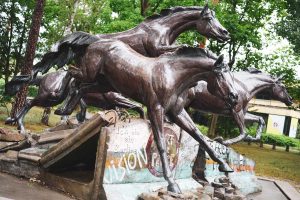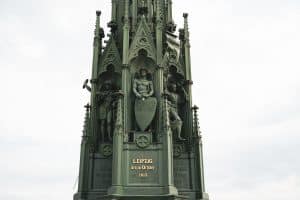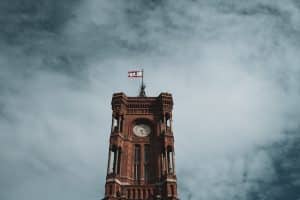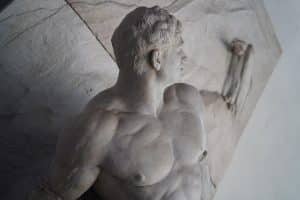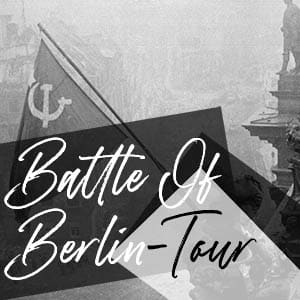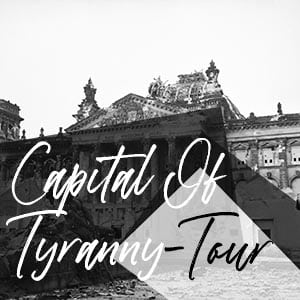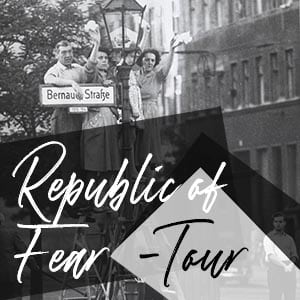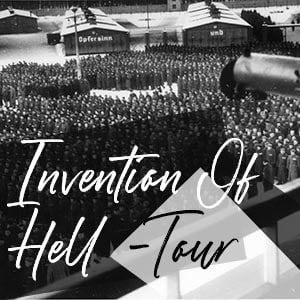To explore Berlin today is to immerse yourself in a cityscape still very much defined by the tumultuous events of its not so distant past.
The current German capital is a patchwork of buildings; restored, repaired, and rebuilt. From the remants of Imperial Prussian grandeur to the stocky tenements of the industrial revolution, East German Plattenbau, and the glass and steel structures of the cosmopolitan contemporary city.
As any seasoned traveller knows, the real cherished city experiences, however, are to be found in-between these markers.
They consist of the conversations, the interactions, the sounds, the smells – and as a matter of orientation (and admiration), the sights.
For this city guide series, we’ve chosen to decisively shift the focus from the macro to the micro – stepping away from the buildings and landmarks to deal instead with the objects that define Berlin and yet similarly serve to anchor any experience in the city.
In total, 365 objects presented in a series of themed guides. To be explored – and read – at leisure. That we intend in-time to expand on with links and maps, additional photos, and commentary. Perhaps even a published calendar or book?
While Berlin’s landmarks may be hard to miss, these objects are mostly hard to find – they are the statues, the graves, the memorials, the token unique items sequestered in museums. Some may even be hiding in plain sight.
Signifiers directly connecting experiences in the past with the present. Punctuation points in the greater story, in the form of treasures, artefacts, and relics.
They elicit commentary about culture, the conditions of a society – and like landmarks, these objects act as more than phyical matter, they are also the materialised essence of the city.
Experience A City In Objects
This collection could continue ad inifinitum – as there is certainly no shortage of objects in Berlin that carry a weight of significance.
As an introduction to this series we’re starting with ten important objects located in the historic centre of the city – Berlin’s Mitte district (with one notable exception).
Far from a definitive guide to the entire city or the story of Berlin’s chequered history through its relics, this is an opportunity to connect the dots – and find stories, secrets, and intrigue embodied in physical form.
To experience the German capital in a different way…
At the bottom of this guide you can also find links to the further parts of this project and explore thematically Berlin’s historical landscape through the remnants and relics left behind.
Now let’s get started…
–
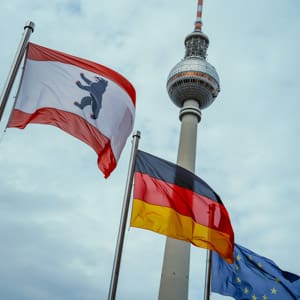
01 | The Berlin Flag
Flying high across the city, accompanying both civil and state offices, the Berlin flag is easily identifiable by its red-white-black colour scheme, and the city mascot – the Berlin Bear. As Berlin is not only a city but also one of the sixteen federal states, you may also spot a slight variation of the civil flag, where the bear appears as a coat of arms – inside a shield capped with a crown. This is the official Berlin State flag, whereas the civil flag features just the lone bear without any decoration – arms stretched out facing the left of the flag.
Importantly, if you’re looking to take one home as a souvenir, bear in mind that it only counts as the genuine article if the grizzly is positioned slightly left on centre – not exactly in the middle!
–
Where is it? Various Locations
Website: None

02 | The Quadriga
Overlooking the historic district of Mitte from atop the Brandenburg Gate is the four-horse drawn chariot – the Quadriga – carrying the goddess Irene. Without a doubt Berlin’s most famous statue this image also features on most 10/20/50 cent coins minted in Germany.
Designed by famed Prussian sculptor, Johann Gottfried Schadow, the Quadriga was added to the Brandenburg Gate in 1793 – and shared the same fate as the Horses of St Mark in Venice when it was looted by French Emperor Napoleon and taken to Paris in 1806. When the Quadriga was finally returned eight years later, the goddess was awarded an Iron Cross – still visible inside the wreath atop her staff.
–
Where is it? Pariser Platz, 10117 Berlin
Website: None
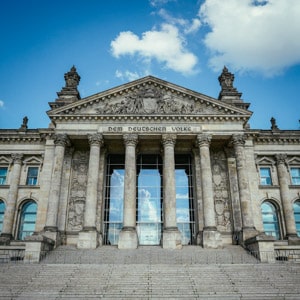
03 | Dem Deutschen Volke
The inscription on the front of the German parliament – Dem Deutschen Volke (to the German people) – has a peculiar history. Added in 1916, during the height of the First World War, the lettering was forged out of bronze canons captured from Napoleon’s forces in the 1800s.
Although originally intended to grace the building when it opened in 1894 – as the architrave was designed for the inscription – it would take more than 20 years of debate about the typography, the meaning of the phrase, and potential alteratives, before it was eventually applied – with the font specially designed by famed typographer Peter Behrens.
–
Where is it? Platz der Republik 1, 11011 Berlin
Website: The Bundestag
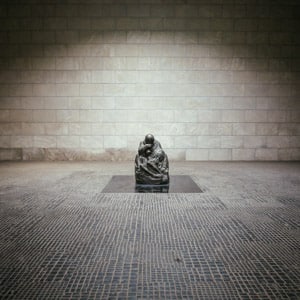
04 | The Neue Wache Pieta
Arguably the most powerful of German artist Käthe Kollwitz’s work, this 1.6m high sculpture – titled ‘Mother with her Dead Son’ – can be found inside a former Prussian guardhouse in central Berlin. A secularised pastiche of Michaelangelo’s Pieta, depicting a mourning mother holding her dead son, this evocative piece was introduced in 1993 as the Neue Wache (New Guardhouse) on Unter den Linden was transformed into the central memorial site for the German state.
Placed directly underneath an oculus, the sculpture is intentionally left open to the elements – meaning that when it rains visitors are confronted with the poignant image of water dripping down the mother’s face like tears.
–
Where is it? Unter den Linden 4, 10117 Berlin
Website: Käthe Kollwitz Museum
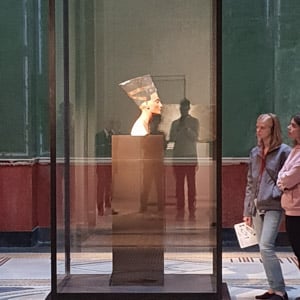
05 | The Bust of Nefertiti
Housed in the Neues Museum is the star attraction of the Berlin state museum’s collection – the bust of Egyptian Queen Nefertiti – face of the American plastic surgeons association and ‘the most beautiful woman to have ever lived’.
Remarkably despite how highly regarded the piece is, as part of the state collection, the bust of Nefertiti is the only artefact on display that visitors are not allowed to photograph – unless stood in the adjoining rooms. It is common practice in museums to forbid flash photography so as not to damage artefacts, certainly here the no-photos policy helps with the sale of postcards – and limits damage to the museum’s bottom line.
–
Where is it? Bodestraße 1-3, 10178 Berlin
Website: Neues Museum

06 | The Ishtar Gate
One of the original seven wonders of the world, the walls of ancient Babylon were constructed more than 2500 years ago by King Nebuchadnezzar II. This ceremonial entrance – named after the goddess Ishtar, previously sat at the end of long processional street and was constructed using glazed bricks mainly of an intense lapis lazuli blue colour while featuring rows of bas-relief animals, representing ancient Babylonian deities.
Although this is the smaller part of the entrance gate, it offers visitors to the Pergamon Museum the rare and exciting opportunity to enter ancient Babylon – without even leaving Berlin.
–
Where is it? Bodestraße 1-3, 10178 Berlin
Website: Pergamon Museum
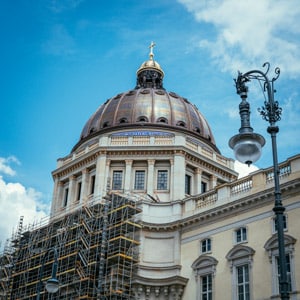
07 | The Stadtschloss Cross
Although the original Stadtschloss was almost entirely destroyed in 1950, this palace-shaped replica now sits on the southern edge of Museum Island – topped with a rather controversial Christian cross bearing the name of its mail-order-catalogue czar benefactor.
An extremely controversial project, not least as in order to make way for this project the former East German parliament (the Palast der Republik) had to fall to the wrecking ball.When finished, this new reconstruction is set to serve as home of the Humboldtforum – with a museum exhibiting non-European art nestled inside this faux-Baroque Prussian residence.
–
Where is it? Schloßplatz, 10178 Berlin
Website: Förderverein Berliner Schloss e.V.
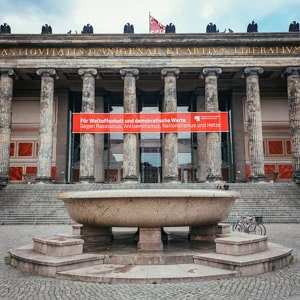
08 | The Granite Bowl
When English Duke of Devonshire, William Cavendish, commissioned the production of a huge granite basin in 1826, Prussian King Frederick William III responded by stating his desire to produce a version that would surpass the British bowl.
Reminiscent of the enormous porphyry basin in the Vatican, this huge Granite Bowl now sits in front of Berlin’s prestigious Altes Museum. With a circumference of 21.7 metres, it is considered the largest bowl in the world made from a single stone. Originally intended for exhibition inside the rotunda of the museum, its size meant it only made it as far as the entrance, in 1831.
–
Where is it? Bodestraße 1-3, 10178 Berlin
Website: Altes Museum
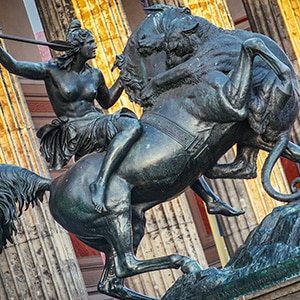
09 | The Mounted Amazon
Installed in 1841 on the steps of Berlin’s Königliches Museum, this life-sized bronze equestrian statue – the work of famous sculptor, August Kiss – depicts a Amazonian warrior being attacked by a panther, spear drawn and about to engage the beast. Kiss famously specialised in mythological and allegorical subjects, often paired with Prussian Neoclassical structures. Caught in the midst of the attack, the figures here expertly convey the violence and emotional tension of the moment.
For several years this statue stood alone on the eastern pedestal at the museum entrance, until a second work – The Lion Fighter by Albert Wolff was added to complete the ensemble. Both works were eventually recast and can also be found outside the Philadelphia Museum of Art.
–
Where is it? Bodestraße 1-3, 10178 Berlin
Website: Altes Museum
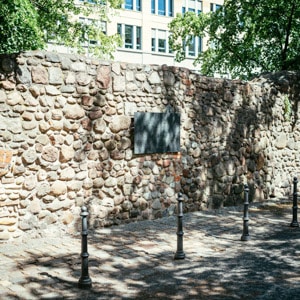
10 | The Berliner Stadtmauer
The original ‘Berlin Wall’, a customs and exise barrier that dates back to the Middle Ages, previously encircled the dual towns of Berlin-Cölln and the royal palace. The only remaining piece in the city is now to be found on Littenstrasse, near Alexanderplatz.
This particular piece survived demolition due to its location and use as a boundary wall for residential buildings that have since been cleared. It was declared a listed protected landmark in 1948. As the city grew, the original Berlin Wall was expanded and linked to medieval gates and fortress gates – the only one still standing now being the Brandenburg Gate at Pariser Platz.
–
Where is it? Waisenstraße 25, 10179 Berlin
Website: None
Our Related Private Tours
Learn more about the Battle of Berlin and explore this urban battlefield with our Battle of Berlin tours.
Learn more about the history of Nazi Germany and life in Hitler’s Third Reich with our Capital Of Tyranny tours.
Learn more about the history of East German and life behind the Iron Curtain with our Republic Of Fear tours.
Learn more about the history of Prussia and the life of Frederick the Great with our Glory Of Prussia tours.
Learn more about the Nazi Concentration Camp industry and visit Sachsenhausen on our Invention of Hell tours.


